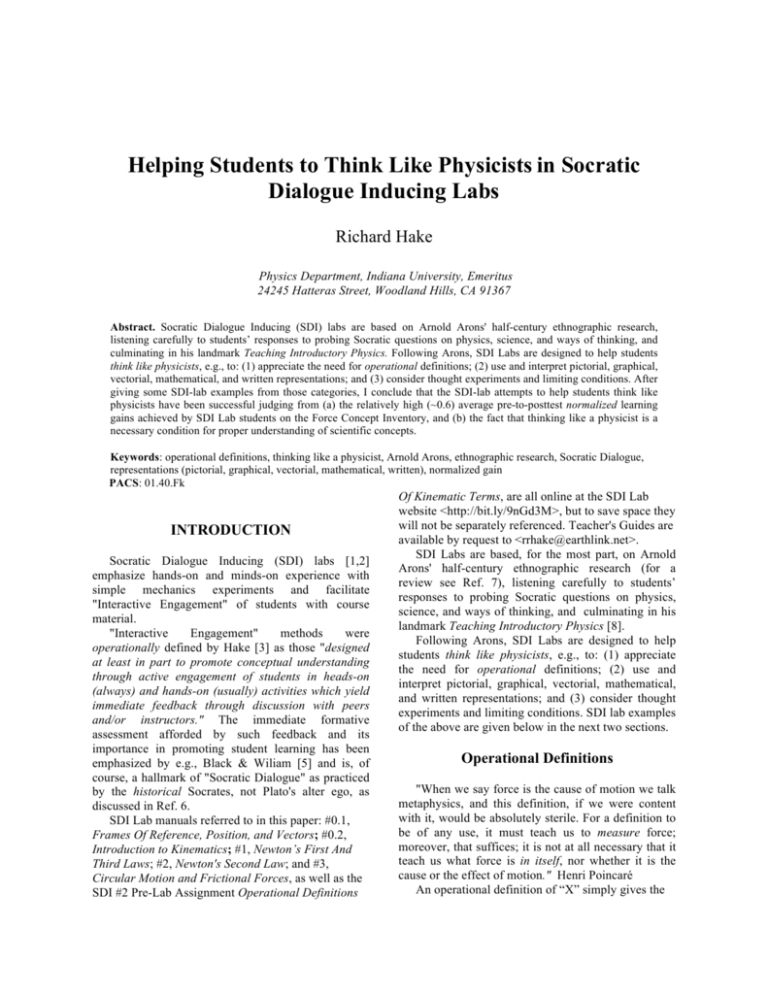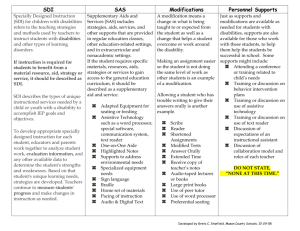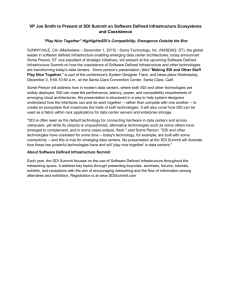Helping Students to Think Like Physicists in Socratic
advertisement

Helping Students to Think Like Physicists in Socratic
Dialogue Inducing Labs
Richard Hake
Physics Department, Indiana University, Emeritus
24245 Hatteras Street, Woodland Hills, CA 91367
Abstract. Socratic Dialogue Inducing (SDI) labs are based on Arnold Arons' half-century ethnographic research,
listening carefully to students’ responses to probing Socratic questions on physics, science, and ways of thinking, and
culminating in his landmark Teaching Introductory Physics. Following Arons, SDI Labs are designed to help students
think like physicists, e.g., to: (1) appreciate the need for operational definitions; (2) use and interpret pictorial, graphical,
vectorial, mathematical, and written representations; and (3) consider thought experiments and limiting conditions. After
giving some SDI-lab examples from those categories, I conclude that the SDI-lab attempts to help students think like
physicists have been successful judging from (a) the relatively high (~0.6) average pre-to-posttest normalized learning
gains achieved by SDI Lab students on the Force Concept Inventory, and (b) the fact that thinking like a physicist is a
necessary condition for proper understanding of scientific concepts.
Keywords: operational definitions, thinking like a physicist, Arnold Arons, ethnographic research, Socratic Dialogue,
representations (pictorial, graphical, vectorial, mathematical, written), normalized gain
PACS: 01.40.Fk
INTRODUCTION
Socratic Dialogue Inducing (SDI) labs [1,2]
emphasize hands-on and minds-on experience with
simple mechanics experiments and facilitate
"Interactive Engagement" of students with course
material.
"Interactive
Engagement"
methods
were
operationally defined by Hake [3] as those "designed
at least in part to promote conceptual understanding
through active engagement of students in heads-on
(always) and hands-on (usually) activities which yield
immediate feedback through discussion with peers
and/or instructors." The immediate formative
assessment afforded by such feedback and its
importance in promoting student learning has been
emphasized by e.g., Black & Wiliam [5] and is, of
course, a hallmark of "Socratic Dialogue" as practiced
by the historical Socrates, not Plato's alter ego, as
discussed in Ref. 6.
SDI Lab manuals referred to in this paper: #0.1,
Frames Of Reference, Position, and Vectors; #0.2,
Introduction to Kinematics; #1, Newton’s First And
Third Laws; #2, Newton's Second Law; and #3,
Circular Motion and Frictional Forces, as well as the
SDI #2 Pre-Lab Assignment Operational Definitions
Of Kinematic Terms, are all online at the SDI Lab
website <http://bit.ly/9nGd3M>, but to save space they
will not be separately referenced. Teacher's Guides are
available by request to <rrhake@earthlink.net>.
SDI Labs are based, for the most part, on Arnold
Arons' half-century ethnographic research (for a
review see Ref. 7), listening carefully to students’
responses to probing Socratic questions on physics,
science, and ways of thinking, and culminating in his
landmark Teaching Introductory Physics [8].
Following Arons, SDI Labs are designed to help
students think like physicists, e.g., to: (1) appreciate
the need for operational definitions; (2) use and
interpret pictorial, graphical, vectorial, mathematical,
and written representations; and (3) consider thought
experiments and limiting conditions. SDI lab examples
of the above are given below in the next two sections.
Operational Definitions
"When we say force is the cause of motion we talk
metaphysics, and this definition, if we were content
with it, would be absolutely sterile. For a definition to
be of any use, it must teach us to measure force;
moreover, that suffices; it is not at all necessary that it
teach us what force is in itself, nor whether it is the
cause or the effect of motion." Henri Poincaré
An operational definition of “X” simply gives the
operations for measuring “X” (Holton & Brush [9]).
Operational definitions are therefore crucial in science
and in critical thinking, even despite the protestations
of the “anti-positivist vigilantes” [10].
An example of SDI Lab's stress on operational
definitions is the prelab assignment "Operational
Definitions Of Kinematic Terms," adapted from Arons
[8, Sections 1.16-1.17, 2.2-3.25]. The assignment is
introduced as follows:
"A.
DEVISE
OPERATIONAL
DEFINITIONS OF KINEMATIC TERMS:
Satisfactory completion of this section will help
to insure that you have entered into the NewtonianLeibnitz world of differential calculus, at least to
the extent of understanding the operational
meaning of the basic kinematic terms and thus
being prepared to consider the experiments in SDI
#2, Newton’s Second Law. Please recall from the
discussion in SDI Labs #0.1 (Frames Of Reference,
Position, and Vectors) and #1 (Newton’s First And
Third Laws) that an operational definition of a
word or words specifies the experimental
significance of those words in terms of welldefined measurement methods. Please indicate, in
your own words and/or sketches [one sketch or
12
graph is worth a teraword (1.0 x 10 words)]
operational definitions of the crucial kinematic
terms given on the following pages."
The first kinematic term that the students are asked to
operationally define is:
"1. Position [HINT: Recall your work in SDI Lab
#0.1. How did you measure your position in that
lab? Recall that your operational definition of
'position' was to have consisted of a sketch of a
your position vector between an origin O and a
point "P" in an xyz-coordinate reference frame,
along with a statement of the operations for
marking the coordinate scales and then measuring
your position coordinates.]"
Just below the above instruction is a rectangular grid
to accommodate student sketches. The "HINT" above,
and in the items below, indicates the extensive
guidance supplied by the SDI lab manual, in addition
to that furnished by the Socratic instructor in response
to students' questions or lab manual entries.
Thus SDI labs, as most other "Interactive
Engagement" methods surveyed by Hake [3,4] are not
"minimally guided," an appellation applied by
[Kirschner, Sweller, & Clark ([11] to "constructivist,
discovery, problem-based, experiential, and inquirybased teaching," who proclaimed them all to be
failures! For counters see Hake [12] and Tobias &
Duffy [13].
Other terms that the students are asked to
operationally define are:
2. Instantaneous Position [HINT: Return to this
after completing "5" below.]
3. Displacement [HINT: Do you recall walking
from one position to another position in the lab as
part of SDI Lab #0.1? How did you define your
displacement vector between your initial and final
positions in terms of initial and final position
vectors?] Draw a diagram!
4. Time [HINT: What instrument measures "time"?
See SDI Lab Ground Rule #5 in SDI Lab #0.1, and
Fig. 1 below.]
Fig. 1. Snapshot sketches at three sequential
instants of time (t1, t2, t3) show a wooden
block sliding to rest on a table as observed in
Sec. IV-C of SDI Lab #1, Newton's First and
Third Laws. The force f is the frictional force
exerted on the block by the table. N is the
Normal force exerted on the block by the
table. F is the force exerted on the block by
the Earth. The V-H axis designates the
Vertical and Horizontal directions.
5. Instant of Time [HINT: What instrument
measures an "instant of time"? See Fig. 1 above.]
6. Clock reading [HINT: Its name is its definition!
See also Fig. 1]
7. Continuous (in time) Motion [HINT: Recall
from your previous study of mathematics that a
continuous function, say y as a function of x or
y(x) is "continuous" if Δy approaches 0 as Δx
approaches 0. In graphical term y(x) is continuous
if the curve y(x) can be drawn with one
uninterrupted motion of a pencil. Applying this to
kinematics, if the displacement x is a continuous
function of the time t, how would the curve of x(t)
(i.e., x as a function of t) appear on a graph? Show
such a curve in the space below and label it
"Continuous."
If the displacement x is a discontinuous
function of the time t, how would the curve of x(t)
appear on a graph? Show such a curve in the space
below and label it "Discontinuous."
How could the continuous curve x(t) shown
above be measured? (This, then, would be an
operational definition of continuous motion.)
Could the discontinuous x(t) curve shown
above represent a physically reasonable situation?
{Y,N,U,NOT}
The letters {Y, N, U, NOT} stand for {Yes, No,
Uncertain, None Of These}. A curly bracket {…}
indicates that students should encircle a response
within the bracket and then, briefly explain or justify
their answers.
8. Time Interval
9. Instantaneous Velocity (Henceforth, in this lab
"velocity" v will always mean "instantaneous
velocity.") [HINT: For simplicity consider only
one dimensional (1D) motion. For an operational
definition of v in the x direction, consider the way
in which you obtained your displacement x vs time
t graph in SDI #0.2, Introduction to Kinematics.
Alternatively, consider taking a sequence of
camera snapshots at equal and closely spaced
intervals of time. Could such a sequence of
snapshots be used to construct a graph of x vs t for
1D motion or for the x component of 3D motion?
{Y, N, U, NOT} How could graphs of x vs t be
used to define instantaneous velocity v in the x
direction?]
10. Uniform Velocity [HINT: "Uniform" simply
means constant in time.]
a. Suppose an object moves at a uniform velocity.
Does it stay at one position during some small time
interval? {Y, N, U, NOT}
11. Instantaneous Acceleration (Henceforth, in
this lab "acceleration" a will always mean
"instantaneous
acceleration.")
[HINT:
The
operations suggested to define instantaneous
velocity v above in "9" will allow the construction
of a v vs t curve. How could such a curve be used
to define instantaneous acceleration?]
12. Uniform Acceleration
13. Inertia [HINT: Newton’s first law is often
called the "law of inertia."]
14. Inertial Reference Frame [HINT: Recall the
discussion of Inertial Reference Frames (IRF) in
the "Forces on a Kid in a Truck" exercise of SDI
Lab #1.]
Measure and Then Derive the
Displacement of a Plate in the Tablecloth
Slipout Trick: Dimensions And Limiting
Conditions
In SDI Lab #3 Circular Motion And Frictional
Forces, students take turns performing the old
"Tablecloth Slipout Trick":
A plumb bob hanging from the ceiling and centered
on the plate allows measurement of displacement δ of
a plate from start to finish of the trick. This trick is
normally done as a qualitative lecture demonstration of
Newton's First Law (wrong! – it demonstrates the
Second Law – see below) to the delight (if not the
enlightenment) of students.
The Lab Manual instructions are as follows:
"Diagram the contact and action-at-a-distance
vector forces Fon dish by X acting on the dish
during the four phases of the motion: (a) dish &
cloth stationary with respect to (wrt) the lab
frame;(b) dish stationary wrt the accelerating
cloth; (c) dish slips wrt the accelerating cloth: (d)
dish slides on the table:
During the downward pull on the tablecloth, the
force applied to the tablecloth increases rapidly in
time. There are four phases to the motion of a dish
just before and during the pull as indicated above.
In the figure above show ALL the force vectors
acting ON the dish during the four phases a, b, c,
and d of the motion. Draw velocity and
acceleration vectors (if they exist) for the dish.
Derive the following expression for δ:
δ = (1/2) µkc g τ2 [ 1 + (µkc / µkt)]...............(1)
In Eq. (1), g is the acceleration due to gravity; τ
is the time required to pull the cloth out from under
the plate (i.e., the time duration of the "phase-c
motion" (see above); and µkc and µkt are the
coefficients of kinetic friction for, respectively, the
plate on the cloth and the plate on the table.
[HINT: Use Newton’s second law, Fnet on body =
mbody abody, to obtain accelerations in terms of µ
and g for the phases b and c of the motion
diagrammed above. (Assume that the distance
moved during phase b is negligible.) Then use the
constant-acceleration kinematic equations to
calculate displacements while the dish is on the
cloth and while the dish is on the table.
Is Eq. (1) physically reasonable? {Y, N, U,
NOT} [HINT: Consider dimensions and the
predicted magnitude of δ for both realistic and
extreme limiting conditions.]"
Eq. (1) has been derived by Haber-Schaim & Dodge
[14].
Has the SDI-Lab Attempt to Help Students
Think Like Physicists Succeeded?
In “Achieving Wider Scientific Literacy,” Arons
[8, Chapter 12] gave, as the first two “hallmarks of
science literacy”:
1. Recognize that scientific concepts . . . . are
invented (or created) by acts of human intelligence
and are not tangible objects or substances
accidentally discovered, like a fossil, or a new
plant or mineral.
2. Recognize that to be understood and correctly
used such terms require careful operational
definition, rooted in shared experience and in
simpler words previously defined; to comprehend,
in other words, that a scientific concept involves an
idea first and a name afterwards, and that
understanding does not reside in the technical
terms themselves.
Thus, in Arons' view, thinking like a scientist (e.g.,
appreciation for operational definitions) is a necessary
condition for proper understanding of scientific
concepts. The fact that SDI Labs have resulted in
relatively high (~0.6) average pre-to-post test
normalized learning gains (Hake [4, Table Ic) on the
Force Concept Inventory [15, 16] suggests that the
SDI-Lab attempt to help students think like physicists
has been relatively successful.
REFERENCES
1. R.R. Hake, "Socratic Pedagogy in the Introductory
physics Lab," Phys. Teach. 30: 546-552 (1992); updated
version (4/27/98) online at <http://bit.ly/9tSTdB>.
2. R.R Hake, “Design-Based Research in Physics Education
Research: A Review,” online at <http://bit.ly/9kORMZ>,
in Handbook of Design Research Methods in Education:
Innovations in Science, Technology, Engineering, and
Mathematics Learning and Teaching, edited by Kelly,
Lesh, & Baek, 2008. Routledge.
3. R.R. Hake, “Interactive-engagement vs traditional
methods: A six thousand- student survey of mechanics
test data for introductory physics courses,” Am. J. Phys.
66(1): 64-74 (1998); online at <http://bit.ly/d16ne6>.
4. R.R. Hake, “Interactive- engagement methods in
introductory mechanics courses” (1998), online at
<http://bit.ly/aH2JQN>, a crucial companion paper to the
preceding reference.
5. P. Black & D. Wiliam, "Inside the black box: Raising
standards through classroom assessment," Phi Delta
Kappan 80(2): 139-148 (1998); online at
<http://bit.ly/c7ZQlr>.
6. R.R. Hake, “The Socratic Method of the Historical
Socrates, Plato's Socrates, and the Law School's
Socrates”; online at <http://bit.ly/b5v58m>. Post of 21
Jun 2007 to AERA-L and other discussion lists.
7. R.R. Hake, “The Arons Advocated Method,” submitted to
the Am. J. Phys. on 24 April 2004; online at
<http://bit.ly/boeQQt>.
8. A.B. Arons, Teaching Introductory Physics. Wiley, 1997.
9. G. Holton & S.G. Brush. Physics the Human Adventure:
From Copernicus to Einstein and Beyond. Rutgers
University Press, 2001.
10. D.C. Phillips, Expanded Social Scientist's Bestiary: A
Guide To Fabled Threats to, and Defenses of,
Naturalistic Social Science. Rowman & Littlefield, 2000.
11. P.A. Kirschner, J. Sweller, & R.E. Clark, “Why Minimal
Guidance During Instruction Does Not Work: An
Analysis of the Failure of Constructivist, Discovery,
Problem-Based, Experiential, and Inquiry-Based
Teaching,” Educational Psychologist 41(2): 75-86
(2006); online at <http://tinyurl.com/3xmp2m>.
12. R.R. Hake ,"Language Ambiguities in Education
Research," submitted to the Journal of Learning Sciences
on 21 August 2008; online at <http://bit.ly/bHTebD>.
13. S. Tobias & T.M. Duffy. Constructivist Instruction:
Success or Failure? Routledge, 2009.
14. U. Haber-Schaim & J.H. Dodge, "There's More to It than
Friction," Phys. Teach. 29(1): 56-57 (1991).
15. D. Hestenes, M. Wells, & G. Swackhamer, "Force
Concept Inventory," Phys. Teach. 30: 141 (1992); online
(but without the test itself) at <http://bit.ly/b1488v>.
16. I Halloun, R.R. Hake, E.P. Mosca, & D. Hestenes,
"Force Concept Inventory, 1995 revision," online
(password protected) at <http://bit.ly/b1488v>.








